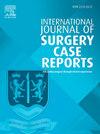Retroduodenal lymphangiomyoma: A rare cause of abdominal pain – A case report
IF 0.6
Q4 SURGERY
引用次数: 0
Abstract
Background
Lymphangiomyomas are rare benign tumors arising from the lymphatic system, most commonly found in the retroperitoneum. Retroduodenal lymphangiomyomas are exceedingly rare and present significant diagnostic challenges due to their nonspecific symptoms and overlapping features with other retroperitoneal and gastrointestinal pathologies.
Case presentation
We report a 48-year-old man with persistent abdominal pain lasting several weeks. Clinical examination and laboratory investigations were unremarkable. Gastroscopy revealed no abnormalities. Contrast-enhanced computed tomography (CT) identified a well-demarcated, non-enhancing retroduodenal soft tissue lesion measuring 36 mm × 30 mm with punctate calcifications, suggestive of a benign process. Endosonography confirmed the lesion's location between the aorta and inferior vena cava. A fine-needle biopsy was avoided due to the lesion's vascular nature. Surgical excision was performed, and histopathological analysis revealed anastomosing vascular channels with smooth muscle proliferation, confirming the diagnosis of lymphangiomyoma. Postoperative recovery was uneventful, and follow-up imaging showed no recurrence.
Discussion
This case underscores the importance of a multidisciplinary approach involving radiology, surgery, and pathology in the diagnosis and management of retroduodenal lymphangiomyomas. Contrast-enhanced CT and histopathology are critical in distinguishing lymphangiomyomas from other retroperitoneal masses. Complete surgical excision remains the definitive treatment to prevent recurrence.
Conclusion
Although rare, retroduodenal lymphangiomyomas should be considered in the differential diagnosis of retroperitoneal masses with nonspecific symptoms.
求助全文
约1分钟内获得全文
求助全文
来源期刊
CiteScore
1.10
自引率
0.00%
发文量
1116
审稿时长
46 days

 求助内容:
求助内容: 应助结果提醒方式:
应助结果提醒方式:


